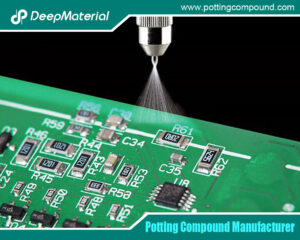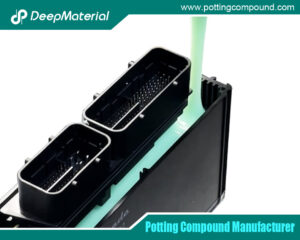
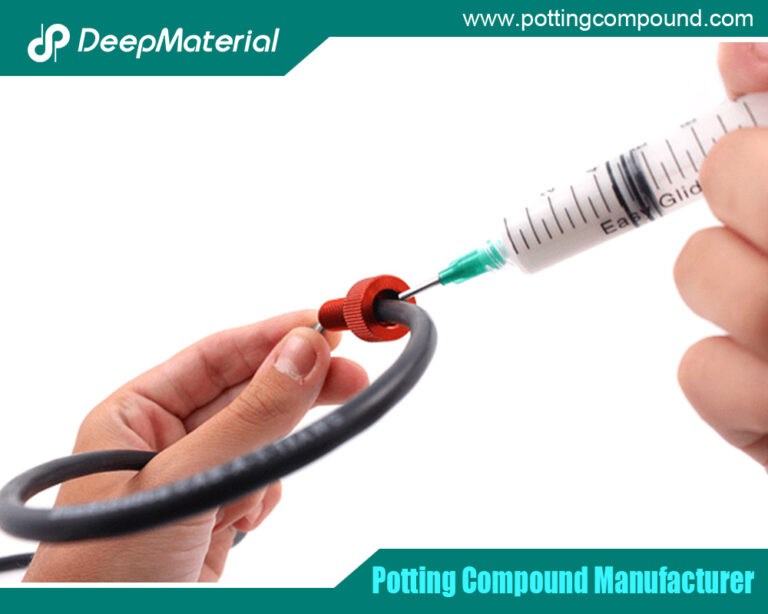
What is Potting Compound Used For?
- Electronic Potting Material Manufacturer
- August 6, 2024
- adhesive glue manufacturer, circuit board potting compound, Connector Potting Compound, deepmaterial adhesive glue, deepmaterial PCB Potting, deepmaterial potting compound, electrical potting compound, electronic encapsulant potting compounds, electronic epoxy encapsulant potting compounds, electronic potting compound, Electronic Potting Compounds Manufacturer, encapsulant potting compounds, Encapsulants and Potting Compounds Suppliers, epoxy encapsulant potting compounds, epoxy potting compound, epoxy potting compound manufacturers, Flexible Potting Compound, industrial adhesive suppliers, LED Potting Compound, PCB Potting Compound, PCB Potting Compound and Conformal Coating Adhesive, polyurethane potting compound, potting compound
What is Potting Compound Used For?
Potting compound, often called potting, is widely used in various industries to encapsulate and protect electronic components. It is crucial in ensuring the durability, reliability, and longevity of sensitive electronic devices and assemblies. This article explores potting compounds’ diverse applications, advantages, considerations, and challenges.
Introduction to Potting Compound
Potting compound is a thermosetting plastic material used to encapsulate electronic components. It protects these components from environmental factors such as moisture, dust, chemicals, mechanical shock, and vibrations. Potting compounds surrounding the electronic assembly provide electrical insulation, thermal management, and structural support.
Understanding Potting Compounds
Composition and Types
Potting compounds are typically formulated from various polymers, each offering specific properties suited to different application requirements:
- Epoxy Resins:Epoxy resins are commonly used in electronics and automotive industries because they are known for their strong adhesion, thermal stability, and chemical resistance.
- Silicone Compounds:Silicones provide excellent flexibility over a wide temperature range, high dielectric strength, and good moisture and UV radiation resistance. They are often used in applications requiring high reliability and durability.
- Polyurethane Resins:Polyurethanes offer flexibility, impact resistance, and moderate chemical resistance. They are preferred for applications where vibration damping and shock absorption are critical.
Properties
The choice of potting compound depends on the specific requirements of the application:
- Electrical Insulation:Potting compounds prevent electrical shorts and ensure reliable performance by providing insulation against high voltages.
- Thermal Management:Many potting compounds offer thermal conductivity, dissipating heat generated by electronic components and thereby extending their operational lifespan.
- Mechanical Protection:They protect fragile components from physical damage caused by handling, transportation, or environmental factors.
Applications of Potting Compounds
Potting compounds are used extensively across various industries due to their versatile protective properties. Here are some key sectors where potting compounds are indispensable:
Electronics Industry
In the electronics industry, potting compounds encapsulate and protect sensitive components such as printed circuit boards (PCBs), sensors, connectors, and power supplies. Encapsulation shields these components from moisture, dust, chemicals, and mechanical stresses, ensuring reliable performance even in harsh environments. Examples include consumer electronics, industrial automation, and telecommunications equipment.
Automotive Industry
In automotive electronics, potting compounds are essential for protecting electronic control units (ECUs), sensors, and actuators from the rigours of vehicle operation. They provide thermal management to withstand temperature variations and vibration resistance to maintain electronic functionality. Potting compounds help automotive systems achieve robustness, reliability, and longevity, which is crucial for safety-critical applications like engine management and advanced driver-assistance systems (ADAS).
Aerospace and Defense
The aerospace and defence sectors demand high-performance materials that withstand extreme conditions such as high altitudes, rapid pressure changes, and temperature variations. Potting compounds protect avionics, radar, missile guidance, and satellite electronics. They ensure the integrity and reliability of critical electronics in aerospace applications where failure is not an option.
Medical Devices
Medical electronics require biocompatible potting compounds to ensure they do not harm patients or interact negatively with bodily tissues. Potting compounds in medical devices such as implantable devices, diagnostic equipment, and surgical instruments provide electrical insulation and protection against bodily fluids and sterilisation processes. These compounds play a vital role in maintaining medical electronics’ safety, reliability, and performance.
Renewable Energy
In renewable energy systems like solar panels and wind turbines, potting compounds protect power electronics from environmental elements such as UV radiation, humidity, and temperature fluctuations. Encapsulation with potting compounds enhances the durability and efficiency of renewable energy systems by preventing corrosion, electrical faults, and premature component failure. This ensures sustainable energy production and operational reliability over the long term.
Advantages of Using Potting Compounds
Potting compounds offer several advantages that contribute to their widespread adoption across industries:
- Environmental Protection:They shield sensitive electronics from moisture, dust, chemicals, and UV radiation, extending their lifespan in diverse operating conditions.
- Electrical Insulation:Potting compounds prevent electrical shorts and enhance the dielectric properties of electronic assemblies, ensuring reliable electrical performance.
- Thermal Management:Many potting compounds possess thermal conductivity properties, dissipating heat generated by electronic components to prevent overheating and maintain optimal operating temperatures.
- Mechanical Stability:They provide structural support and vibration damping, protecting components from mechanical shock and physical damage during handling and operation.
- Chemical Resistance:Potting compounds resist exposure to various chemicals, oils, solvents, and cleaning agents commonly encountered in industrial and automotive environments.
Factors to Consider When Choosing Potting Compounds
Selecting the suitable potting compound involves considering several factors to ensure compatibility and optimal performance:
- Application Requirements:Specific environmental conditions, temperature ranges, and performance expectations dictate the choice of potting compound.
- Material Compatibility:Ensure compatibility with the materials used in the electronic assembly to prevent chemical reactions or degradation over time.
- Curing Time and Process:Consider the curing method (heat cure, room temperature cure) and curing time required for the potting compound to achieve complete mechanical and electrical properties.
- Regulatory Compliance:Verify compliance with industry standards and regulations such as UL ratings, RoHS (Restriction of Hazardous Substances), and REACH (Registration, Evaluation, Authorization, and Restriction of Chemicals) for environmental and safety considerations.
Challenges and Limitations
While potting compounds offer numerous benefits, they also present challenges that need to be addressed:
- Pot Life and Shelf Life:Potting compounds have limited pot life once mixed and often limited shelf life in storage conditions, requiring careful planning during application.
- Material Compatibility Issues:Incompatibility with certain substrates or chemicals can reduce the performance or premature failure of encapsulated electronics.
- Cost Considerations:High-performance potting compounds may involve higher material costs, impacting overall project budgets and economic feasibility.
- Handling and Safety:Due to their chemical composition or curing process, some potting compounds may require special handling procedures or safety precautions.
Future Trends and Innovations
Future advancements in materials science and technology are expected to drive further innovation in potting compounds. Future trends may include:
- Development of bio-based and environmentally friendly potting materials.
- Integration of nanotechnology for enhanced thermal and electrical properties.
- Continued optimization for miniaturisation and lightweighting of electronic assemblies.
- Enhanced compatibility with emerging electronic components and substrates.
As industries demand higher performance and reliability from electronic devices, potting compounds will remain integral to achieving these goals through advanced encapsulation and protection technologies.
This comprehensive article covers the breadth of information about potting compounds, from their composition and applications to advantages, considerations, challenges, and future trends. If you have any specific additions or modifications you’d like to make, feel free to let me know!
Conclusion
Potting compounds play a critical role in modern electronics by providing encapsulation and protection and enhancing electronic assemblies’ performance and reliability. Their diverse applications span industries ranging from electronics and automotive to aerospace, medical devices, and renewable energy systems. By understanding the specific requirements, properties, advantages, and challenges associated with potting compounds, engineers and manufacturers can make informed decisions to ensure the longevity and reliability of electronic devices in various demanding environments.
For more about what is potting compound used for?, you can pay a visit to DeepMaterial at https://www.pottingcompound.com/ for more info.
Recent Posts
- What Are the Core Differences Between Different Conformal Coating Types?
- The Benefits of Conformal Coating for Electronics Products
- Conformal Coating Spray
- UV Curing Potting Compound
- The Ultimate Guide to Electrical Potting Compound and Market Application
- The Top Polyurethane Potting Compound
- Advanced Epoxy Potting Compound for Superior Electronic Protection
- Waterproof Potting Compound: A Comprehensive Guide
- Silicone Potting Compound for Electronics
- Potting Compound vs. Epoxy: A Comprehensive Comparison
Tags
Related Posts

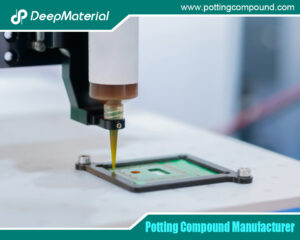
The Benefits of Conformal Coating for Electronics Products
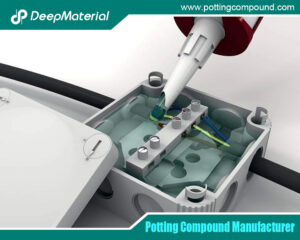
Conformal Coating Spray
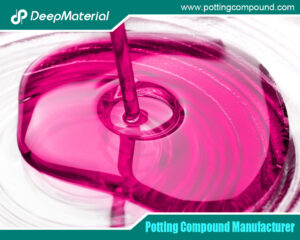
UV Curing Potting Compound
